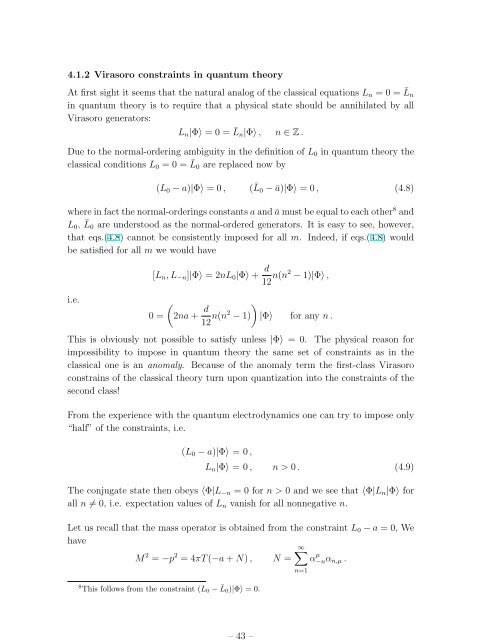Lectures on String Theory
Lectures on String Theory
Lectures on String Theory
You also want an ePaper? Increase the reach of your titles
YUMPU automatically turns print PDFs into web optimized ePapers that Google loves.
– 43 –<br />
4.1.2 Virasoro c<strong>on</strong>straints in quantum theory<br />
At first sight it seems that the natural analog of the classical equati<strong>on</strong>s L n = 0 = ¯L n<br />
in quantum theory is to require that a physical state should be annihilated by all<br />
Virasoro generators:<br />
L n |Φ〉 = 0 = ¯L n |Φ〉 , n ∈ Z .<br />
Due to the normal-ordering ambiguity in the definiti<strong>on</strong> of L 0 in quantum theory the<br />
classical c<strong>on</strong>diti<strong>on</strong>s L 0 = 0 = ¯L 0 are replaced now by<br />
(L 0 − a)|Φ〉 = 0 , (¯L 0 − ā)|Φ〉 = 0 , (4.8)<br />
where in fact the normal-orderings c<strong>on</strong>stants a and ā must be equal to each other 8 and<br />
L 0 , ¯L 0 are understood as the normal-ordered generators. It is easy to see, however,<br />
that eqs.(4.8) cannot be c<strong>on</strong>sistently imposed for all m. Indeed, if eqs.(4.8) would<br />
be satisfied for all m we would have<br />
[L n , L −n ]|Φ〉 = 2nL 0 |Φ〉 + d 12 n(n2 − 1)|Φ〉 ,<br />
i.e.<br />
0 =<br />
(<br />
2na + d )<br />
12 n(n2 − 1) |Φ〉 for any n .<br />
This is obviously not possible to satisfy unless |Φ〉 = 0. The physical reas<strong>on</strong> for<br />
impossibility to impose in quantum theory the same set of c<strong>on</strong>straints as in the<br />
classical <strong>on</strong>e is an anomaly. Because of the anomaly term the first-class Virasoro<br />
c<strong>on</strong>strains of the classical theory turn up<strong>on</strong> quantizati<strong>on</strong> into the c<strong>on</strong>straints of the<br />
sec<strong>on</strong>d class!<br />
From the experience with the quantum electrodynamics <strong>on</strong>e can try to impose <strong>on</strong>ly<br />
“half” of the c<strong>on</strong>straints, i.e.<br />
(L 0 − a)|Φ〉 = 0 ,<br />
L n |Φ〉 = 0 , n > 0 . (4.9)<br />
The c<strong>on</strong>jugate state then obeys 〈Φ|L −n = 0 for n > 0 and we see that 〈Φ|L n |Φ〉 for<br />
all n ≠ 0, i.e. expectati<strong>on</strong> values of L n vanish for all n<strong>on</strong>negative n.<br />
Let us recall that the mass operator is obtained from the c<strong>on</strong>straint L 0 − a = 0, We<br />
have<br />
∞∑<br />
M 2 = −p 2 = 4πT (−a + N) , N = α −nα µ n,µ .<br />
8 This follows from the c<strong>on</strong>straint (L 0 − ¯L 0 )|Φ〉 = 0.<br />
n=1

















